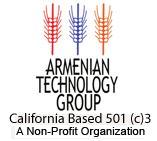May 2, 1995
As part of its effort to promote Armenia’s agricultural self-sufficiency, the Armenian Technology Group teamed up with the University of California at Davis in the 1995 spring semester to familiarize veterinarians from Armenia and Georgia with the latest research and techniques in controlling animal diseases.
A group of seven veterinarians — four from Armenia and three from Georgia — received three weeks of intensive training in March and April under the auspices of the UC-Davis School of Veterinary Medicine. Faculty members of the school, ranked among the leaders in its field, introduced their counterparts from the Transcaucasus to newly developed diagnostic tools and reviewed the approaches used in the United States to maintain the health of livestock. The Armenian and Georgian veterinarians also visited several dairy and ranching operations in California’s central valley.
Armenia’s livestock industry was hit hard by the economic crisis that has struck the newly independent republic. Under Soviet rule, Armenia received most of its feed grain and hay by rail from other Soviet republics. Since 1989, however, neighboring Azerbaijan has imposed a transportation blockade against Armenia in its effort to defeat the self-determination struggle of Armenians in Mountainous Karabagh. The Azerbaijani blockade, combined with the breakdown of trade ties among former Soviet republics, has decimated Armenia’s stock of cattle, pigs, and sheep.
In the winters of 1991-92 and 1992-93, Armenian farmers were forced to slaughter thousands of their animals. Armenia’s lack of energy — another ramification of the Azerbaijani blockade — idled much of the country’s agricultural equipment, such as tractors, harvesters, milking machines, and refrigerated storage facilities.
At the same time, Armenia underwent the most far-reaching program of agricultural privatization in the former Soviet Union. During the first two winters of Armenia’s independence, most individual farmers, often with a single cow or a few pigs, found the means to feed their animals. The equipment of collective farms, however, was largely under-utilized. A further step toward privatization in 1994 addressed this problem by allowing farmers to buy the facilities of the Soviet-era collectives. Recent months have seen the formation of larger, more efficient operations in Armenian agriculture.
The California-based Armenian Technology Group (ATG) has worked closely with Armenian farmers and agricultural specialists to help restore the republic’s livestock industry. In addition to its focus on veterinary medicine, ATG has developed projects to boost Armenia’s production of alfalfa. In 1994, ATG received funding from the U.S. Agency for International Development to plant more than 45,000 acres of Armenian farmland with winter wheat seed from the United States. Ultimately, ATG hopes to play a role in improving nutrition in the republic by assisting in the modernization of Armenia’s dairy and meat processing facilities.
In addition to its implications for agricultural, veterinary medicine is critical for human health. More than 200 diseases, including tuberculosis, anthrax, and rabies, may be transmitted from animals to humans. The break-up of the Soviet Union has injected a political dimension into the challenge of epidemiology. The diseases that afflict animals in Armenia are the same throughout the Transcaucasus region, and yet there has been little coordination among neighboring countries. The participation of veterinarians from both Armenia and Georgia in the UC-Davis program promises to foster cooperation between the two countries in the field of agriculture.
While in California, the Armenian and Georgian veterinarians were introduced to the state’s Veterinary Diagnostic Laboratory System. The system, headquartered at UC-Davis and supported by five regional labs, is staffed with veterinarians trained to protect farm animals against disease.
The Armenian and Georgian veterinarians also compared notes with Dr. Jack Morse, leader of a 13-person veterinary practice in Turlock, California, and Dr. Robert Bushnell, veterinary extension specialist for UC-Davis. Both men serve on ATG’s board of directors and have worked as technical advisors for the organization. Dr. Arthur Hazarabedian, chairman of ATG and himself a veterinarian, envisions a network of laboratories similar to the California system for Armenia. Hazarabedian and Dr. Bennie Osburn, associate dean of the UC-Davis School of Veterinary Medicine, were responsible for organizing the visit of the Armenian and Georgian veterinarians. Funding was provided by the U.S. Agency for International Development.
For more information about how you can help Armenia’s farmers, contact the ATG office at (559) 224-1000 or by e-mail (info@atgusa.org). Tax-deductible donations can be sent to ATG; 1300 E. Shaw, Suite 149; P.O.Box 5969; Fresno, CA 93755-5969.
You may also donate to ATG online.

Follow Us